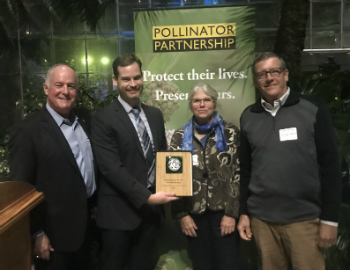NACD WELCOMES ANNUAL MEETING SPEAKER
 NACD added Soil Health Institute (SHI) President and CEO Dr. Wayne Honeycutt to the speaker line-up for the 2019 Annual Meeting in San Antonio, Texas. Dr. Honeycutt will be featured on a soil health panel during Tuesday's general session. As a leader in the soil health movement, Honeycutt will describe emerging issues and resources for soil health, as well as partnership opportunities for conservation districts. NACD added Soil Health Institute (SHI) President and CEO Dr. Wayne Honeycutt to the speaker line-up for the 2019 Annual Meeting in San Antonio, Texas. Dr. Honeycutt will be featured on a soil health panel during Tuesday's general session. As a leader in the soil health movement, Honeycutt will describe emerging issues and resources for soil health, as well as partnership opportunities for conservation districts.
 At SHI, Honeycutt leads the Institute's programs to safeguard and enhance the vitality and productivity of soils. He previously served for five years as deputy chief for science and technology with the Natural Resources Conservation Service (NRCS) in Washington, D.C., as well as 10 years as a research leader and 14 years as a research soil scientist for the USDA Agricultural Research Service (ARS). Honeycutt holds a bachelor’s degree in forestry, a master’s degree in soil science and a Ph.D. in soil genesis. At SHI, Honeycutt leads the Institute's programs to safeguard and enhance the vitality and productivity of soils. He previously served for five years as deputy chief for science and technology with the Natural Resources Conservation Service (NRCS) in Washington, D.C., as well as 10 years as a research leader and 14 years as a research soil scientist for the USDA Agricultural Research Service (ARS). Honeycutt holds a bachelor’s degree in forestry, a master’s degree in soil science and a Ph.D. in soil genesis.
To learn more about the natural resource-centered events at NACD’s 73rd Annual Meeting, including breakout sessions, conservation symposia, tours and more, visit NACD’s Annual Meeting webpage.
NACD, NAPPC HONOR FARMER-RANCHER POLLINATOR AWARD RECIPIENTS
On Oct. 16, NACD Northeast Region Representative and Policy Specialist Eric Hansen joined Val Dolcini, President and CEO of the Pollinator Partnership, to present the North American Pollinator Protection Campaign’s (NAPPC) U.S. Farmer-Rancher of the Year award to John and Nancy Hayden.

The Haydens have been proprietors of The Farm Between in Jeffersonville, Vt., since 1992. The Farm Between is a 20-acre certified organic nursery and fruit farm specializing in production and sale of pollinator-dependent fruit and berry crops, shrubs and trees. More than half of the farm’s area is devoted to pollinator habitat enhancement. John established a 14-acre pollinator sanctuary at a former dairy farm, where he conducts long-term bee species diversity monitoring and demonstrates effective pollinator land management practices.
The award was presented during NAPPC’s annual conference in Washington, D.C. NACD is a member of NAPPC, whose mission is to raise awareness about the importance of pollinators, encourage partnerships that work on behalf of pollinators, promote conservation of pollinator habitat, and support pollinator research.
AWARD NOMINATIONS DEADLINE APPROACHES
Time is running out to recognize conservation leaders on a national stage through two award opportunities:
The Hugh Hammond Bennett Award for Conservation Excellence is sponsored by the National Conservation Planning Partnership (NCPP), offering the opportunity to recognize an outstanding producer and conservation planners from within the NCPP and our partners who have exemplified outstanding service through development and implementation of sound conservation planning and other conservation techniques. A nomination packet with additional information and criteria is available on NACD’s awards webpage.
Each state must submit their state-level winner by Nov. 2, 2018, for a final, national winner to be chosen. The awards will be presented at the 2019 NACD Annual Meeting in San Antonio, Texas, in February.
The Olin Sims Conservation Leadership Award is an award named for an outstanding advocate for voluntary conservation and an NACD past president who we lost in 2007. In honor of his memory and through this award, NACD and NRCS annually recognize an up-and-coming leader who demonstrates excellence in promoting and leading voluntary conservation on private lands. Work with your state conservationist’s office to submit a nomination for this award. The deadline for each state’s nomination is Nov. 26.

BLUE WATER CONSERVATION DISTRICT, MICHIGAN
Blue Water Conservation District (BWCD) is improving wildlife habitat through a $50,700 grant the district received from the Michigan Department of Natural Resources (DNR).
The Michigan DNR Wildlife Habitat Grant must be used by Sept. 30, 2020, on projects including enhancing large wetland complexes, winter deer complexes, mast producing food sources, forest openings, oak savannas and small-game habitat.

BWCD, which serves St. Clair and Sanilac counties, will use the funds to convert 86 acres of row crops into native grasses, wet grass mix and wildflower mix in Sanilac County.
Once the current project is implemented, BWCD farm bill wildlife biologist Jacob Northuis plans to seek funding for forest management planning.
For now, the district is focusing on pheasant population because it’s a struggling species in this area, but the conversion will also draw other small game, such as wild turkeys and Eastern cottontail rabbits.
Read more about BWCD’s work in the most recent edition of Forestry Notes.
|
|
|
|
|
Email Marketing By
|


|
|
|
|
|